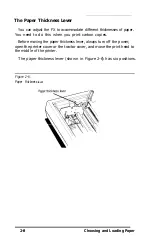
Sending printer commands with BASIC
You can send printer commands with any programming language.
The examples in this manual are written in BASIC, because BASIC is
included with most computer systems.
In most forms of BASIC, and in particular Microsoft’” BASIC, the
normal method of producing printed output is to use the LPRINT
statement followed by the text to be printed enclosed in quotation
marks, as shown below:
100 LPRINT "This text will be printed."
Individual printer control codes can be sent by using the CHR$
function with the LPRINT statement:
110 LPRINT CHR$(27);CHR$(69);
This line sends ASCII codes 27 and 69 to the printer, selecting
emphasized printing.
Most versions of BASIC permit the ASCII codes in the CHR$
function to be given in either decimal (as above) or hexadecimal. Also,
if the code corresponds to a printable character, the character itself can
be used in quotation marks in the LPRINT statement. The command
shown above could therefore be given in two other forms:
LPRINT CHR$(27);"E"
LPRINT CHR$(&H1B);CHR$(&H45)
As you can see, Microsoft BASIC uses &H to denote hexadecimal
numbers.
If you have another version of BASIC or a different programming
language, consult the manual for the language to find the correct
formats for these commands.
Using the FX with Application Programs
3 - 7
















































